04modeling
advertisement
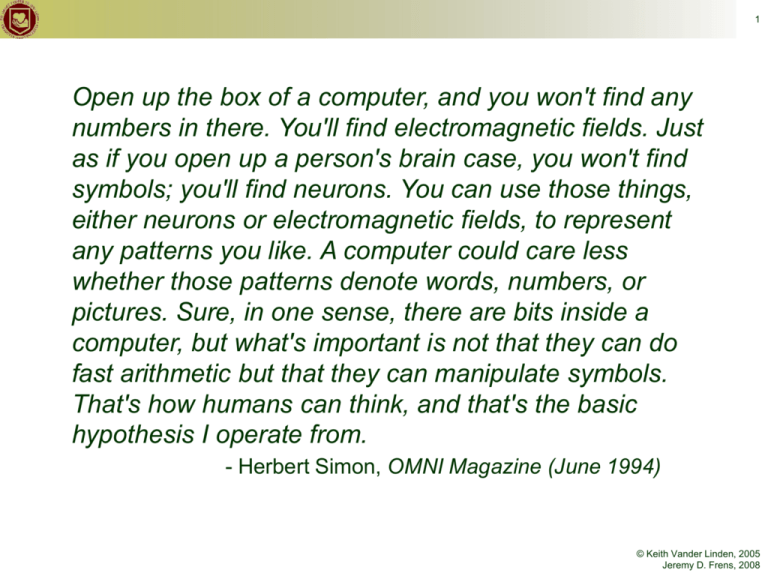
1 Open up the box of a computer, and you won't find any numbers in there. You'll find electromagnetic fields. Just as if you open up a person's brain case, you won't find symbols; you'll find neurons. You can use those things, either neurons or electromagnetic fields, to represent any patterns you like. A computer could care less whether those patterns denote words, numbers, or pictures. Sure, in one sense, there are bits inside a computer, but what's important is not that they can do fast arithmetic but that they can manipulate symbols. That's how humans can think, and that's the basic hypothesis I operate from. - Herbert Simon, OMNI Magazine (June 1994) © Keith Vander Linden, 2005 Jeremy D. Frens, 2008 2 Digital Modeling ● ● Digital computers perform operations on represented data. All data is represented by numbers. – ● What kinds of data (or information) are there? Mixed success: – A wide range of things can be modeled. – Some things are very difficult to model. © Keith Vander Linden, 2005 Jeremy D. Frens, 2008 3 Binary ● ● Binary is a base-2 numbering system. A bit is a “binary digit”: 0 (or “off”) – 1 (or “on”) – ● Binary is just as powerful as decimal -- no more or less. Decimal Binary 0 0 1 1 2 10 3 11 4 100 5 101 6 110 7 111 8 1000 9 1001 10 1010 11 1011 12 1100 13 1101 14 1110 15 1111 © Keith Vander Linden, 2005 Jeremy D. Frens, 2008 4 Decimal Numbers Decimal numbers are base-10 (using digits 0-9) 123 1*102 + 2*101 + 3*100 1*100 + 2*10 + 3*1 100 + 20 + 3 © Keith Vander Linden, 2005 Jeremy D. Frens, 2008 5 Binary Numbers Binary numbers are base-2 (using digits 0 & 1) 1102 1*22 + 1*21 + 0*20 1*4 + 1*2 + 0*1 + + 4 2 0 = 610 © Keith Vander Linden, 2005 Jeremy D. Frens, 2008 6 Digitizing Numbers ● Numbers are represented in memory using a binary encoding scheme. – Storing positive numbers is pretty obvious. – What about negative numbers? – What about “decimals”? – What about really really really big numbers? ● That’s why there are standard “encoding schemes”. © Keith Vander Linden, 2005 Jeremy D. Frens, 2008 7 Digitizing Characters ● Each character is assigned an integer value. – Programs keep track of which memory locations store character data. – Programs display the right glyph on the screen. ● Two common schemes: – ASCII – Unicode © Keith Vander Linden, 2005 Jeremy D. Frens, 2008 8 ASCII ● ● American Standard Code for Information Interchange. Uses 7 bit integers – ● Extended ASCII uses 8 bit integers – ● 27 = 128 different characters 28 = 256 characters ASCII is the most common code currently used. Character ASCII Code A 100 0001 B 100 0010 C 100 0011 D 100 0100 … … a 110 0001 b 110 0010 c 110 0011 d 110 0100 … … 0 011 0000 1 011 0001 2 011 0010 3 011 0011 … … <space> 010 0000 . 010 1110 … … © Keith Vander Linden, 2005 Jeremy D. Frens, 2008 9 Unicode ● Uses 8 - 32 bit integers – ● over a million characters defined. Unicode supports a number of different character types. – Cyrillic – Ancient Coptic – All charts © Keith Vander Linden, 2005 Jeremy D. Frens, 2008 10 Social justice and computing ● What’s the Big Idea The accessibility of computers and readable character sets can be seen as an issue of social justice. © Keith Vander Linden, 2005 Jeremy D. Frens, 2008 11 Digitizing Big Data ● Using numbers and characters, we can digitize and model bigger things: – – – – – – ● Documents Accountant’s ledger City maps Human behaviors Calendars Images, audio, video Programs make sense of the data. © Keith Vander Linden, 2005 Jeremy D. Frens, 2008 12 Digitizing Multimedia Data ● Multimedia data is usually – – ● HUGE And highly patterned Compress the data by taking advantage of the patterns to take up less space. – – Lossless compression doesn’t lose any information. Lossy compression loses some information for better compression. © Keith Vander Linden, 2005 Jeremy D. Frens, 2008 13 Digitizing Images ● ● An image is an array of pixels. Each pixel has: – – ● intensity values for Red, Green & Blue an optional alpha value for transparency Common image file formats include: – PNG: Lossless, often seen on the web – GIF: Lossless, 256 colors max, but patented – JPEG: Lossy, compression 3:1 to 60:1 – TIFF: Lossless – BMP: Uncompressed Windows format image from Harry Plantinga © Keith Vander Linden, 2005 Jeremy D. Frens, 2008 14 Use of Image Formats ● ● ● ● ● PNG: web, logos and text GIF: web, logos and text, animation JPEG: photos TIFF: imaging software BMP: never © Keith Vander Linden, 2005 Jeremy D. Frens, 2008 15 Steganography ● ● Cryptography encrypts messages using encryption keys. Steganography hides messages in other digital media. ImagesVander from www.wikipedia.org © Keith Linden, 2005 Jeremy D. Frens, 2008 16 Digitizing Audio ● ● Sound can also be digitized. Common sound file formats: mp3 – open, patented, no DRM, older/less effective wma – Windows Media Audio, patented/proprietary, DRM AAC – Apple’s iTunes, patented, proprietary, DRM RealAudio – patented, proprietary, DRM Ogg Vorbis – unpatented, open, no DRM © Keith Vander Linden, 2005 Jeremy D. Frens, 2008 17 Digitizing Video ● Common movie file formats: mpeg – Open (but patented) standard avi – Windows Media Player DV – As used in digital camcorders divx – very high compression ratios © Keith Vander Linden, 2005 Jeremy D. Frens, 2008 18 How does a computer know what it is looking at? ● Windows tells what kind of thing is being modeled by looking at a file’s suffix (or extension) : – – – – – ● .txt: text file (in ASCII or Unicode) .jpg, .png, .bmp: image .xls, .xlsx: Excel spreadsheet .zip: a compressed folder of files/folders. .doc, .docx, .rtf: Word documents Linux stores file type in the file itself. © Keith Vander Linden, 2005 Jeremy D. Frens, 2008 19 The Difficulty of Modeling What’s the Big Idea ● Not everything can be easily modeled. ● “I praise you because I am fearfully and wonderfully made.” - Psalm 139:14 © Keith Vander Linden, 2005 Jeremy D. Frens, 2008

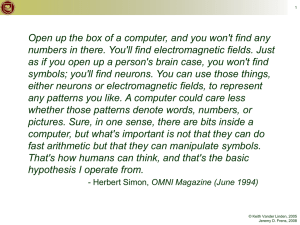
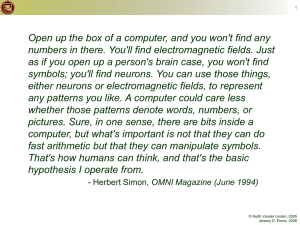
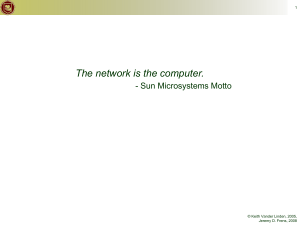
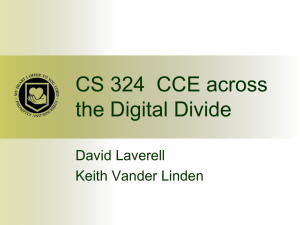
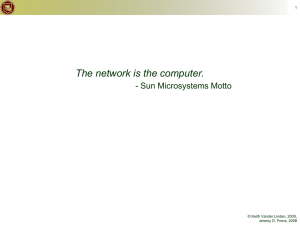

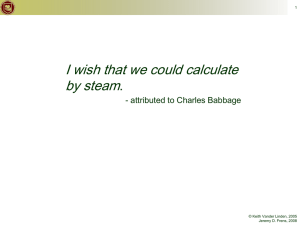
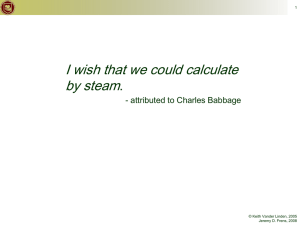
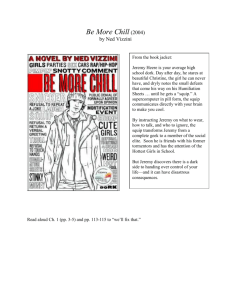
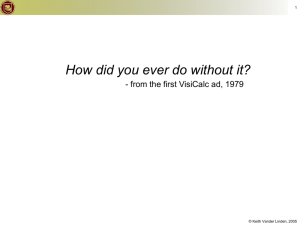
![[#SWF-809] Add support for on bind and on validate](http://s3.studylib.net/store/data/007337359_1-f9f0d6750e6a494ec2c19e8544db36bc-300x300.png)